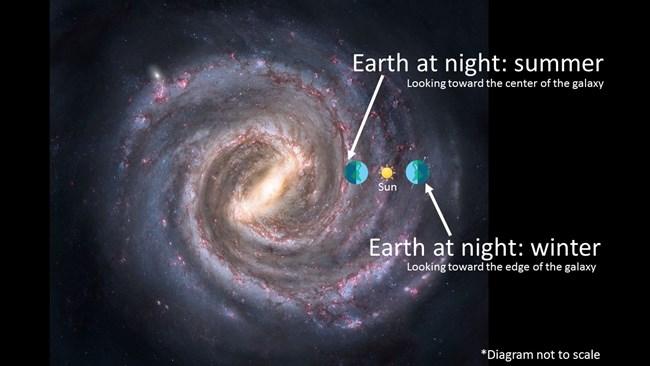
Photo by Joyce Tanihara Many of the darkest skies in the country are found at national parks. Some visitors may come from places where light pollution hinders views of the night skies. Others may never have experienced an unobstructed view of a starry night sky or the Milky Way. Black Canyon of the Gunnison National Park was certified as an International Dark Sky Park in September 2015. The park has exceptional opportunities to view night skies, as well as stargazing programs scheduled throughout the summer months. 
NPS graphic Stargazing at Black CanyonThe park does not close and allows for night sky viewing at all hours. Overlooks that are far from the road are better shielded from the light of passing cars. These locations are great for stargazing, using a personal telescope, or for astrophotography:
Areas at the bottom of the canyon, like East Portal, are suitable for viewing, but the amount of visible sky will be reduced. Visiting in the winter? Enjoy the unique experience of cross-country skiing by moonlight or headlamp. Red light-equipped headlamps or flashlights are best to help preserve night vision and reduce light pollution. Viewing times and seasonsExperiencing moonlight in such a dark place can be extraordinary. However, bright light from the moon means faint stars and the Milky Way are not visible. The best time to view our galaxy is during the new moon phase, or at times when the moon rises late in the night. Check the moon phase, moonrise, sunrise, and sunset times for Black Canyon. The Milky Way shines brighter in the summer than the winter. This is because we face the center of our galaxy on summer nights, while we face the edge of our galaxy on winter nights. As we look to the center, we look at the combined light of more stars than when we look toward the edge. In the summer, the Milky Way rises higher and higher throughout the night, resting directly overhead late in the evening. During the fall, the Milky Way appears directly overhead very early in the evening. 
NPS Photo/C. Roundtree Program OfferingsPark rangers, volunteers, and members of the Black Canyon Astronomical Society (BCAS) work together to provide astronomy programs. These events occur frequently at the park during the summer. Programs are free to visitors who have paid the park entrance fee. Programs may include:
For KidsCheck out the Junior Ranger Night Explorer program, which encourages young park visitors to explore the starry side of their national parks. Activities include learning about stars and galaxies, writing creative mythology about constellations, and using all senses to explore the night environment at a national park. Pick up a free booklet from the visitor center or download online. 
Poster by Tyler Nordgren 2025 Moon Phases
|
Last updated: November 13, 2025


